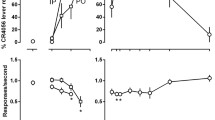Abstract
Male Sprague-Dawley rats were trained to discriminate 3.2 mg/kg yohimbine HCl from saline in a two-lever operant procedure. Generalization tests indicated that piperoxane, another α2-adrenergic blocker with anxiogenic properties in humans, produces yohimbine-like discriminatieffects. In contrast to yohimbine and piperoxane, many other agents were discriminated as vehicle, including corynanthine, raubasine, phentolamine, prazosin, WB-4101, mianserin, tolazoline, and mezilamine. Diazepam caused a dose-related antagonism of yohimbine's stimulus properties. A partial antagonism of yohimbine cueing was also obtained with meprobamate, phenobarbital, chlordiazepoxide, and clonazepam. These results suggest that yohimbine discrimination in rats may be a useful model for detecting agents with anxiolytic activity.
Similar content being viewed by others
References
Borowski E, Starke K, Ehrl H, Endo T (1977) A comparison of pre- and postsynaptic effects of α-adrenolytic drugs in the pulmonary artery of the rabbit. Neuroscience 2:285–296
Clineschmidt BV, Flataker LM, Faison E, Holmes R (1979) An in vivo model for investigating α1- and α2-receptors in the CNS: Studies with mianserin. Arch Int Pharmacodyn Ther 242:59–76
Colpaert FC, Lal H, Niemegeers CJE, Lenaert FM, Janssen PAJ (1975) Investigations on drug-produced and subjectively experienced discriminative stimuli. I. The fentanyl cue: A tool to investigate subjectively experienced drug actions. Life Sci 16:705–716
Colpaert FC, Rosecrans JA (eds) (1978) Stimulus properties of drugs: Ten years of progress. Elsevier, Amsterdam
Davis M, Redmond Jr DE, Barabon JM (1979) Noradrenergic agonists and antagonists effects on conditioned fear as measured by the potentiated startle paradigm. Psychopharmacology 65:111–118
Doxey JC, Smith CFC, Walker JM (1977) Selectivity of blocking agents for pre- and postsynaptic α-adrenoceptors. Br J Pharmacol 60:91–96
Goldenberg M, Snyder CH, Aranov Jr H (1947) New test for hypertension due to circulating epinephrine. JAMA 135:971–976
Guerreo-Figueroa R, Gallant DM, Galatas RF, Rye MM (1972) Effects of yohimbine on CNS structures: Neurophysiological and behavioral correlations. Psychopharmacologia 25:133–145
Harper B, Hughes IE (1979) Presynaptic α-adrenoceptor blocking properties among tri- and tetra-cyclic antidepressant drugs. Br J Pharmacol 67:511–517
Ho BT, Richards DW, Chute DL (eds) (1978) Drug discrimination and state-dependent learning. Academic Press, New York
Holmberg G, Gershon S (1961) Autonomic and psychic effects of yohimbine hydrochloride. Psychopharmacologia 2:93–106
Lal H, Shearman GT (1980) Internoceptive discriminative stimuli in the development of CNS drugs and a case of animal model of anxiety. Annu Rep Med Chem 15:51–58
Lal H (ed) (1977) Discriminative stimulus properties of drugs. Adv Behav Biol 22
Lang WJ, Gershon S (1963) Effects of psychoactive drugs on yohimbine-induced responses in conscious dogs. A proposed screening procedure for anti-anxiety agents. Arch Int Pharmacodyn Ther 142: 456–472
Leighton J, Butz KR, Parmeter LL (1979) Effects of α-adrenergic agonists and antagonists on neurotransmission in the rat anococcygeus muscle. Eur J Pharmacol 58:27–38
Margolis R, Prieto P, Stein L, Chinn S (1971) Statistical summary of 10,000 male cases using afrodex in treatment of impotence. Curr Ther Res 13:616–622
Möhler H, Okada T, Heitz P, Uirich J (1978) Biochemical identification of the site of action of benzodiazepines in human brain by 3H-diazepam binding. Life Sci 22:985–996
Robson RD, Antonaccio MJ, Saelens JK, Liebman J (1978) Antagonism by mianserin and classical α-adrenoceptor blocking drugs of some cardiovascular and behavioral effects of clonidine. Eur J Pharmacol 47:431–442
Shearman GT, Lal H (1980) Generalization and antagonism studies with convulsant, GABAergic and anticonvulsant drugs in rats trained to discriminate pentylenetetrazol from saline. Neuropharmacology 19:473–479
Shearman G, Lal H (1978) Differential responding controlled by the discriminative stimuli produced by convulsant drugs in the rat. Psychopharmacology 58:10
Shearman G, Lal H (1979) Discriminative stimulus properties of pentylenetetrazol and bemegride: Some generalization and antagonism tests. Psychopharmacology 64:315–319
Soffer A (1954) Regitine and benodaine in the diagnosis of pheochromocytoma. Med Clin North Am 38:375–384
Starke K (1977) Regulation of noradrenaline release by presynaptic receptor systems. Rev Physiol Biochem Pharmacol 77:1–124
Starke K, Borowski E, Endo T (1975) Preferential blockade of presynaptic α-adrenoceptors by yohimbine. Eur J Pharmacol 34:385–388
Tanaka T, Starke K (1980) Antagonist/agonist-preferring α-adrenoceptors or α1/α2 adrenoceptors? Eur J Pharmacol 63:191–194
U'Prichard DC, Greenberg DA, Snyder SH (1977) Binding characteristics of a radiolabeled agonist and antagonist of central nervous system alpha-noradrenergic receptors. Mol Pharmacol 13:454–473
Weitzell R, Tanaka T, Starke K (1972) Pre- and postsynaptic effects of yohimbine stereoisomers on noradrenergic transmission in the pulmonary artery of the rabbit. Naunyn-Schmiedebergs Arch Pharmacol 274:18–45
Wilkberg JES (1979) The pharmacological classification of adrenergic α1 and α2 receptors and their mechanism of action. Acta Physicol Scand (Suppl) 468:11–99
Winter JC (1978) Yohimbine-induced stimulus control in the rat. Arch Int Pharmacodyn Ther 235:86–92
Author information
Authors and Affiliations
Rights and permissions
About this article
Cite this article
Browne, R.G. Anxiolytics antagonize yohimbine's discriminative stimulus properties. Psychopharmacology 74, 245–249 (1981). https://doi.org/10.1007/BF00427103
Received:
Accepted:
Issue Date:
DOI: https://doi.org/10.1007/BF00427103




